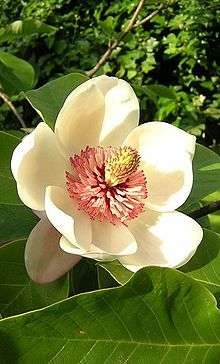Magnolia × wieseneri
Magnolia × wieseneri is a hybrid plant in the genus Magnolia and family Magnoliaceae. A small tree or large shrub with white highly fragrant blooms, it is the progeny of Magnolia sieboldii and Magnolia obovata.[1]
| Magnolia × wieseneri | |
|---|---|
 | |
| Hybrid parentage | Magnolia sieboldii × Magnolia obovata |
| Cultivar | x wieseneri |
| Origin | Japan |
Hybrid
The origins of Magnolia × wieseneri are obscure, but it is thought to have been a result of deliberate cross-breeding between the parent species some time in the 19th century or earlier in Japan, where it is known as Gyo Kusui or Ukesaki Oyama-renage. It entered European horticulture at the 1889 Paris Exposition, where it was on display at the Japanese Court stand. From here, it was collected for Kew Gardens, and named Magnolia × watsonii by Joseph Hooker in 1891. However, Élie-Abel Carrière had named a specimen six months earlier in 1890 after a Mr Wiesener, who had purchased a plant from a Japanese horticulturist at the Trocadéro at the same time as the Exposition, and hence the French botanist's name was preserved under International Code of Botanical Nomenclature naming rules.[1]
Description
Magnolia × wieseneri is a multistemmed large shrub or small tree which may reach 6 m (20 ft) in height; it has leathery obovate green leaves that reach 20 cm (8 in) long by 10.5 cm (4 in) wide. Its most notable feature is the remarkable fragrance of the ivory-coloured flowers, which has been likened to pineapples and seen adjectives such as "ethereal", "spicy" and "aromatic" used.[1] The flowers are cup-shaped at first, with a diameter of 10-12.5 cm (4–5 in), before flattening out to a diameter of 15–20 cm (6–8 in) after a few days.
Cultivation
A chance seedling, from the garden of Sir Peter Smithers at Vico Morcote in Switzerland, with more vigorous growth and larger flowers has been described as Magnolia "William Watson".[1] The garden owner Smithers observed that there were specimens of M. obovata flowering nearby and that the cultivar is possibly a backcross with obovata.[2]
References
- Gardiner, Jim (2000). Magnolias: A Gardener's Guide. Portland, Oregon: Timber Press. pp. 288–89. ISBN 0-88192-446-6.
- Callaway, Dorothy Johnson (1994). The world of magnolias. Portland, Oregon: Timber Press. p. 210. ISBN 0-88192-236-6.